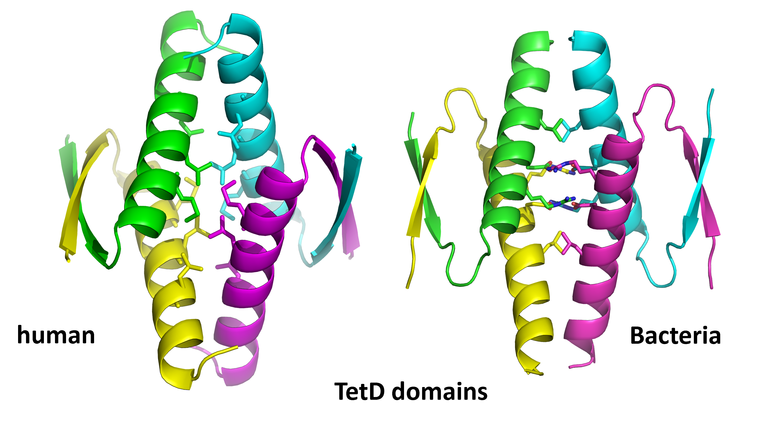Do you want to keep up to date? Subscribe to our newsletter. 1 mail every 2 months! |
 |

Representation of the structures of the TetD domains from human (left panel) and bacterial (right panel). Note the high similarity between these structures, which has persisted throughout billions of years of evolution.
Cerdanyola del Vallès, 28th July 2023 Transcription is a universal process in all living organisms, in which a gene's DNA sequence is copied (transcribed) to make an RNA molecule, as a first step to synthetize proteins for the organism functions.
Transcription factors are proteins that control the rate of gene transcription by binding to a specific DNA sequence. Their function is to regulate—turn on and off—genes in order to make sure that they are expressed in the desired cells at the right time and in the right amount throughout the life of the cell and the organism.
An ALBA research team leaded by Roeland Boer, XALOC beamline responsible, has been studying one of these proteins, called RcopLS20. It is a bacterial transcriptional regulator that exerts its function through the formation of a DNA loop by binding to two regions that are separated by about 75 base pairs (subunits that DNA is made of). RcopLS20 contains a tetramerization domain that is responsible for inducing this DNA looping.
The mechanisms of transcriptional regulation are very different in prokaryotes (bacteria) and eukaryotes (humans, for example). To date, no structural homology has been reported between the tetrameric DNA loop-inducing proteins from eukaryotes and prokaryotes. Now, the ALBA research team used synchrotron light to analyse the structure of the RcopLS20 tetramerization domain (RcoTetpLS20) and compare it with the tetramerization domain of p53, a well-known human protein family related with the occurrence of cancer.
The results show that the RcopLS20 tetramerization domain has high structural similarity when compared to human p53. So, for the first time it has been reported that bacterial RcoTetpLS20 forms tetramers and adopts a similar structure to the p53 human protein family. Scientists have called this identified transcription factor protein domain in bacteria and humans as TetD.
"The discovery that this transcription factor domain, called TetD, exists in bacteria and humans with a similar function is a big surprise. It suggests that the basic principles of the system functions are very similar, despite the obvious differences between bacteria and humans." explains Nerea Bernardo, one of the research team members. The work described here suggests a common regulatory mechanism that exists in all kingdoms of life and that controls gene transcription, which is mediated by TetDloop. Researchers' hypothesis is that it originated from a common ancestor predating the occurrence of multicellular life and has persisted throughout billions of years of evolution.
Moreover, "the human protein that incorporates the TetD domain is an oncogene and related with the occurrence of cancer. Our study will hopefully aid in the understanding of the regulation of cancer development." adds Isidro Crespo, postdoctoral researcher at XALOC.
Resolution of protein structure with synchrotron light
For this work, researchers employed macromolecular crystallography for the determination of the structure of the bacterial TetD domain. First of all, they produced and purified the RcopLS20. After that, RcoTetpLS20 crystals had to be obtained. Protein crystallization is not an easy work as it requires large amounts of pure protein and testing more than 800 different conditions to have a chance of crystallization. The crystals took three months to grow and were then harvested for X-ray diffraction data collection at XALOC beamline at ALBA, cryocooling them by direct transfer from the crystallization drop into liquid nitrogen. Finally, after the data collection and processing, the structure was deposited in the Protein Data Bank.
In addition, researchers used biophysical assays available at ALBA to study the in vitro behaviour of the purified proteins to confirm the structural results obtained by macromolecular crystallography. Finally, AlphaFOLD2 AI system was used to generate a computational model of the full-length protein, which contains the TetD domain. These models agree with the structural and biochemical data and provide a view on the function of the protein in the context of the nucleus.
Reference: Nerea Bernardo, Isidro Crespo, Anna Cuppari, Wilfried J. J. Meijerb and D. Roeland Boer. A tetramerization domain in prokaryotic and eukaryotic transcription regulators homologous to p53. Acta Cryst. (2023). D79, 259–267. https://doi.org/10.1107/S2059798323001298




